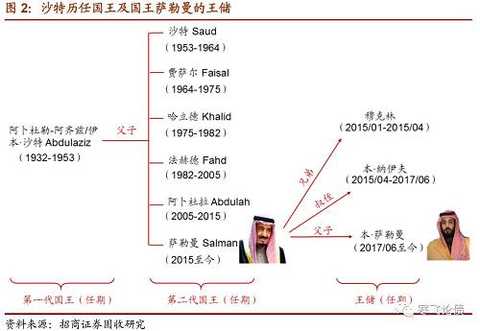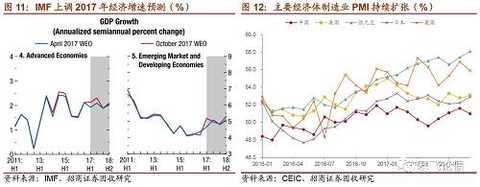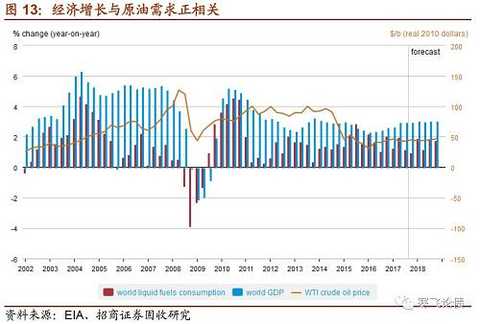This article was first published on WeChat public account: Han Fei on debt. The content of the article belongs to the author's personal opinion and does not represent the position of Hexun.com. Investors should act accordingly, at their own risk. In summary, the current oil price is actually somewhat "overshooted", the impact of geopolitical shocks will gradually dissipate, and oil prices will face a correction in the short term. Although the demand for crude oil is gradually picking up, the supply of crude oil will rise sharply after the rise in oil prices, which will suppress demand. Future demand will determine the “lower limit†of oil prices, while supply will become the “five-finger mountain†to suppress oil prices. With the global demand picking up, the lower limit of the oil price and the center will rise. In 2018, the US oil price will fluctuate in the range of 50~60 USD/barrel, which will promote the global inflation level. The pace of “exiting loose†in Europe and the United States may accelerate. Risk warning: regulatory policy exceeds expectations text Since mid-October, oil prices have risen strongly. Stimulated by the “Saudi Palace Fight†and “Expected Production Expectationsâ€, the oil price has reached a new high in more than two years: the Brent spot price has exceeded the psychological and technical barrier of USD 60/barrel, and the WTI spot price has also exceeded USD 55. / barrel of the mark. If the oil price continues to rise, it will directly push up the global inflation level, which will affect the monetary policy of central banks, causing investors' concerns. Below we will combine the fundamentals of the recent crude oil market to analyze the future trend of oil prices. June 21 this year, King Salman "waste Changli child," Saudi "right game" prelude. The Saudi throne follows the parallel hereditary system, "the brother and the younger brother". Since the death of the first generation of King Ibn Saudi, six sons have succeeded. However, after the new King Salman Bin Abdulaziz was enthroned in 2015, he broke the traditional inheritance rules. Salman first set up his own scorpion as the Crown Prince, and later in June appointed his son Mohammed bin Salman ( called " MBS" by the media ) as the new Crown Prince, dethroning his nephew Mohammu. The crown prince of Mohammed bin Nayef and the Minister of Internal Affairs. MBS was born in 1985. It was the second heir to the throne, the second deputy prime minister and defense minister, and the youngest defense minister in the world. Prince Nayef, born in 1959, has long been the most trusted Saudi royal family in Washington. member. After his father inherited the throne in early 2015 , the influence of MBS in Saudi Arabia has risen rapidly. Its policy agenda mainly includes two aspects: 1. The reform of Saudi Arabia’s “economic diversificationâ€; 2) The implementation of a tough foreign policy. The listing of Saudi state-owned oil company Aramco is at a core low in its economic diversification reform program and is expected to raise $1 trillion in funds for Saudi sovereign wealth funds. In 2016, MBS announced that Saudi Arabia will achieve “de-petroleumization†of the economy by 2020. In addition, MBS recently announced plans to build a $500 billion "super city" NEOM and promote its listing. NEOM covers an area of ​​26,500 square kilometers and will rely mainly on renewable energy. However, since King Salman has been over eight years old, under the circumstance of many elderly princes and princes, the Crown Prince MBS is still in crisis. Consolidating his position in the vast royal family of Saudi Arabia has become his top priority. The ongoing "anti-corruption storm" is the Crown Prince. The impact of the Saudi political battle on the crude oil market is mainly reflected in two aspects: 1) The “production reduction agreement†increases the probability of prolongation. Crown Prince MBS will continue to promote economic reform plans. Before Aramco's listing (expected to be listed in 2018), Saudi Arabia will work to maintain a high level of oil prices, so it will work to promote the extension of the "production reduction agreement." A major factor driving the recent rise in oil prices is the high-profile claim by Saudi oil chief Khalid Al-Falih to “re-balance†the crude oil market by “whatever it takes†to lower crude oil inventories. His statement was also supported by the Crown Prince MBS and Russian President Vladimir Putin. However, Saudi Arabia’s push for production cuts is not “new†for the crude oil market; in the long run, the “de-petroleum†strategy of the Crown Prince MBS (including the construction of a new energy city NEOM) is in fact unfavorable for oil prices: Saudi oil consumption The number is second only to the United States, China, India, and Japan, ranking 5th in the world. 2) Geopolitical risk premium increases. With the rise of the Crown Prince MBS, Sunni Saudi Arabia’s position on the Shi’ite Iran is becoming more “hawkishâ€. On November 3, the Sunni Lebanese Prime Minister Saad Hariri announced his resignation in Jakarta after being summoned by Saudi Arabia and accused Iran of manipulating Hezbollah to threaten its personal safety. Hariri’s allegations have put Lebanon in a war crisis. On November 4, after the military successfully intercepted a missile that was fired from Yemen to Riyadh, Saudi Arabia publicly blamed it on the enemy of Iran and claimed that it was Iran’s armed aggression and could be regarded as a "war act." (act of war). On November 6, Saudi Arabia fired five missiles to bomb the Yemeni capital. Saudi Arabia and Iran's crude oil output amounted to approximately 1,40 0 million barrels, more than OPEC 40% yield, once full-scale war, crude oil supply will cause a huge impact. As the supply and demand of the crude oil market is increasingly balanced, the geopolitical risk premium is also an important reason for the recent sharp rise in oil prices. On the whole, the probability of the "reduction of production agreement" by the Crown Prince MBS is not much, and because of the situation in the Middle East, the possibility of a "comprehensive war" between Saudi Arabia and Iran is very small. Recently, the rapid rise in oil prices may exist. Tune." 2 , crude oil supply: "production reduction agreement" for others to marry clothes 1 OPEC : Exemption The “reduction of production expectations†for OPEC is the most important factor driving up the recent oil price. The deadline for the current “production reduction agreement†is the end of March 2018. OPEC Secretary-General Balkindu said on Wednesday that there is currently no strong opposition from participating countries to production cuts. It is widely expected that the “production reduction agreement†will be extended to the end of 2018 at the OPEC meeting on November 30th. We have mentioned many times in previous reports that the biggest problem with the “production reduction agreement†is that “the foundation is unstableâ€: for a single oil-producing country, in the case of production reduction in other oil-producing countries, the “optimal strategy†should be Increase production instead of production. This is also illustrated by the implementation of the “production reduction agreement†since November 2016. Most of OPEC's efforts to reduce production have been "in vain" in the face of increased production in the United States. Among non-OPEC countries, the United States is the country that has the greatest impact on supply growth. Since November last year, the US crude oil production has increased by more than 900,000 barrels per day. If oil prices remain high, the US will increase production. According to recent data, US crude oil output has recovered from the hurricane's heavy losses, and along with the rise in oil prices, the latest US crude oil production data for the week of November 3 reached 9.62 million barrels per day, since 1983. New height. In summary, the market's expectations for the “production reduction agreement†are also too high. The United States, Libya, Nigeria, and Russia are just a microcosm of the behavior of oil-producing countries under the “production reduction agreementâ€. As oil prices rise, the supply of crude oil will also accelerate, restricting oil prices from rising further and setting a “ceiling†for oil prices. 3. Crude oil demand: global economic recovery, raising the lower limit of oil prices The supply side impact will gradually dissipate, and crude oil demand will be the key to determining the price of oil in the future. Since the beginning of this year, despite the constant geopolitical conflicts, the global economic recovery has shown good resilience. The recent kinetic energy is getting stronger and stronger, and the economic growth of major countries has “resonanceâ€, which will undoubtedly boost demand for crude oil. In the latest version of the World Economic Outlook (WEO) released in October, the IMF raised its 2017 global economic growth forecast from 3.6% to 3.7%, significantly higher than the 3.2% growth in 2016. Current major energy organization According to our report in the report "The Oil" monkey fled Wuzhishan, the Fed read the "tightening curse" - "interest and oil", assuming that the average WTI oil price in November and December is 55 US dollars / barrel, we expect 10 by simple regression. The WTI oil prices in November and December were 0.13%, 0.31% and 0.57% respectively for the US CPI. Due to the low base in November last year, if the oil price in December is maintained at 55 US dollars / barrel, it will likely create a larger pull on the US CPI. However, estimates based on simple regression analysis ignore the residents' alternative consumption, and from the perspective of residuals, they will overestimate the contribution of energy to CPI when oil prices fluctuate drastically . Overall, the current oil price is actually somewhat "overshooted", the impact of geopolitical shocks will gradually dissipate, and oil prices will face a correction in the short term. Although the demand for crude oil is gradually picking up, the supply of crude oil will rise sharply after the rise in oil prices, which will suppress demand. Future demand will determine the “lower limit†of oil prices, while supply will become the “five-finger mountain†to suppress oil prices. With the global demand picking up, the lower limit of the oil price and the center will rise. In 2018 , the price of US oil will fluctuate in the range of 50~60 USD / barrel, which will promote the global inflation level. The pace of “exiting loose†in Europe and the United States may accelerate. This fabric sample has many uses and can be used to make a variety of clothes. The fabric has a soft texture and uses very good materials. Fabric Swatches,Beach Shorts,Beach Trousers,Summer Beach Dresses Yangzhou Youju E-commerce Co.,Ltd , https://www.yzxygarments.com![[Hanfei on debts and special features] Chaos in the Middle East provokes oil monkeys, Wuzhishan reinforced and difficult--interest·oil·record (II) (Xu Hanfei/Tan Zhuo) 20171109](http://i.bosscdn.com/blog/ae/6d/19/760b977c9494a9319b0a0ac6d9.jpg)
1. Middle East chaos: the rise of Saudi strong people, crude oil prices "overshoot" 
From the data point of view, the exempted countries have increased their production substantially, and the “production reduction agreement†has been greatly reduced. OPEC countries have different implementations of the “production reduction agreementâ€. Saudi Arabia, Iran, Qatar, Venezuela and Angola have performed well, but in September this year, the implementation of other countries was below 90%. Due to the large reduction in OPEC's "big brother", if you do not consider Libya and Nigeria, OPEC has been "overfulfilled" with a target of 1.16 million barrels per day. However, Libya and Nigeria have been "free rides" and continue to increase production. Compared with the “baseline production†in October 2016, the two countries increased production by more than 6 million barrels per day in September this year, making OPEC production reduction from 121% (excluding exempt countries) to “waist†to 62% (including Exempt country). ![[Hanfei on debts and special features] Chaos in the Middle East provokes oil monkeys, Wuzhishan reinforced and difficult--interest·oil·record (II) (Xu Hanfei/Tan Zhuo) 20171109](http://i.bosscdn.com/blog/4c/fc/de/ab822a308bbd4d5f1b392e10cd.jpg)
2United States: Accelerated production is accelerating 
In the future, the United States has the potential to continue to increase its production substantially. In the previous report, we mentioned that the production of the “young†Permian production area in the United States continues to rise, becoming the main production of shale oil in the United States, and there are still 8 to 9 years of development potential in the future. At present, the break-even cost of the Delaware Basin and the Midland Basin in the Permian region is only around US$40/barrel. Since mid-October, the WTI oil price has stabilized at US$50/barrel, which will undoubtedly stimulate the shale oil producers to further increase production. Out. From the historical data, shale oil supply has a high price elasticity. 
In the latest World Oil Outlook (WOO2017) released on November 7, OPEC raised its forecast for North American shale oil production by 60% to 7.5 million barrels per day in 2021, of which 5.1 million barrels came from United States. OPEC expects shale oil production to gradually decline until 2025. ![[Hanfei on debts and special features] Chaos in the Middle East provokes oil monkeys, Wuzhishan reinforced and difficult--interest·oil·record (II) (Xu Hanfei/Tan Zhuo) 20171109](http://i.bosscdn.com/blog/90/c3/ec/5f57df5474d0ed716511fbe243.jpg)
In addition, the wide spread of Brent-WTI will stimulate US crude oil exports. Before the US lifted the crude oil export ban in 2015, Brent prices were significantly higher than WTI, mainly reflecting the situation of US crude oil supply and excess reserves. However, after the export ban was lifted, the difference between the two gradually narrowed. However, due to the adverse impact of the hurricane impact on exports, the Brent-WTI spread has begun to widen since the end of August, currently exceeding $6. From 2016 to the first half of this year, Brent-WTI did not spend more than $3 most of the time. This will stimulate the rest of the world to “arbitrage†the import of more WTI crude oil from cost-sensitive refineries. This will also curb Brent's oil price further. In the week of October 27, US crude oil exports reached 2.13 million barrels per day, a record high. 
Coincidentally, Russia has also increased the intensity of crude oil exports. Russia, the world's largest oil producer, has reduced its output by 300,000 barrels per day, following the “production reduction planâ€. However, Russia’s crude oil exports have increased continuously this year, with an average increase of 160,000 barrels per day, which undoubtedly also allowed Russia’s The effect of reducing production has been compromised. 
In the "reasonable" price range, the increase in economic growth will push up the demand for crude oil, which will benefit the oil price. Historically, global economic growth has been positively correlated with demand for crude oil. However, when crude oil prices are too high, it will in turn curb demand for crude oil. For example, in 2007, despite the global economic growth rate of 5%, but because the oil price is too high (WTI rose from less than 60 US dollars / barrel to nearly 100 US dollars / barrel), global crude oil demand is also falling. After the financial crisis broke out, oil prices plummeted. 
![[Hanfei on debts and special features] Chaos in the Middle East provokes oil monkeys, Wuzhishan reinforced and difficult--interest·oil·record (II) (Xu Hanfei/Tan Zhuo) 20171109](http://i.bosscdn.com/blog/ff/8d/61/fddddbcd9b3890e69d8cf4dbf6.jpg)
As the crude oil market gradually enters into “rebalancing†and oil prices touch the psychological barrier, investors will become more sensitive to supply and demand data, and oil price fluctuations will increase. After the news of the Middle East chaos and OPEC production cuts stimulated the crude oil market, the recent data from the fundamentals gave the market a little cold water. EIA inventory data unexpectedly rose 2.23 million barrels in the week of November 3 released on Wednesday, which exceeded expectations (reduced by 2.1 million barrels); crude oil output hit a record high; the decline in crude oil exports made investors worry that stocks would rise further. . China’s import and export data released on the same day showed that China’s crude oil imports slipped from 9 million barrels per day in September to about 7.5 million barrels per day in October, the lowest since October 2016. The oil price therefore has a correction. These data show that the recent rapid rise in oil prices has been in excessive optimistic expectations and will fall back in the short term. ![[Hanfei on debts and special features] Chaos in the Middle East provokes oil monkeys, Wuzhishan reinforced and difficult--interest·oil·record (II) (Xu Hanfei/Tan Zhuo) 20171109](http://i.bosscdn.com/blog/97/98/d8/89ca13f7064cc8cd2613a3a03a.jpg)
![[Hanfei on debts and special features] Chaos in the Middle East provokes oil monkeys, Wuzhishan reinforced and difficult--interest·oil·record (II) (Xu Hanfei/Tan Zhuo) 20171109](http://i.bosscdn.com/blog/3f/6d/6a/445cc9ed7db55f89bbbe94fd63.jpg)
4. The rise of the oil price center will accelerate the normalization of European and American currencies. ![[Hanfei on debts and special features] Chaos in the Middle East provokes oil monkeys, Wuzhishan reinforced and difficult--interest·oil·record (II) (Xu Hanfei/Tan Zhuo) 20171109](http://i.bosscdn.com/blog/6d/d0/42/9138c23368fad6fa676b7c9b18.jpg)
WTI central hypothesis 2018 price of $ 55 / barrel, the estimated breakdown of energy for driving the US CPI will be between 0.2% ~ 0.5%, the US CPI will be back on the 2%, the Fed will raise interest rates again or 3 times. Once the price of oil is stable at 60 US dollars / barrel, it will also form a certain pull on China's CPI .
It is a fabric designed in China. It can be used to make beach pants, which can be worn on the beach in the hot summer, and can also be used to make trousers, etc. It has a wide range of uses.